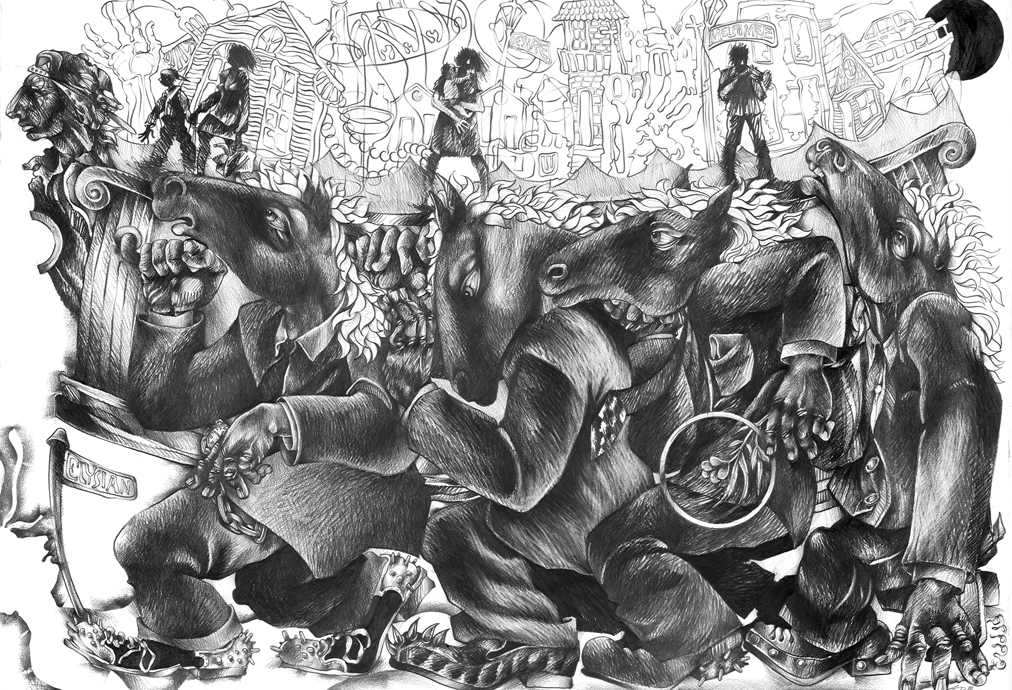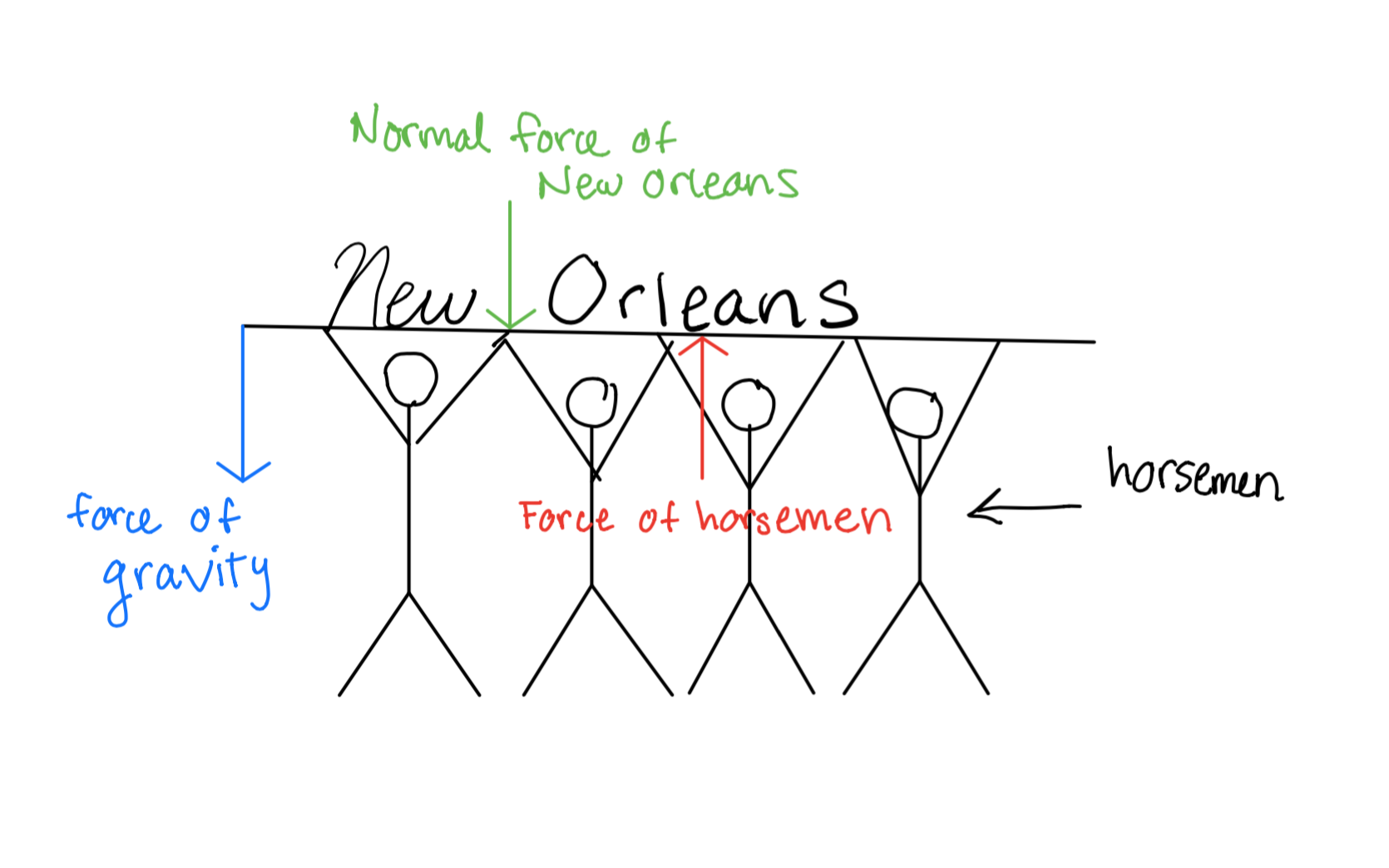Where most of my thoughts surrounding Joe Moran’s Interdisciplinarity once centered around the manner in which language defines or informs science and vice versa, a comment from Dr. McCoy in lecture a few weeks ago caused me to look back to the art of Steve Prince and reminded me of the intersection between the humanities and sciences that occurs within many of his works. Dr. McCoy stated that she would like it if someone could explain to her the physics behind the horsemen and their carrying of what appears to be a representation of the city of New Orleans in Prince’s piece entitled, “Dirge.”

Dr. McCoy’s inquiry inspired me to craft a blog post attempting to explain the physics behind the horsemen’s action and in the process perhaps glean the significance behind the physics found within Prince’s art. Of course, no physics explanation would be complete without art in the form of a free-body diagram. My free-body diagram features a simplistic, stick figure version of Prince’s “Dirge” and featured three arrows representing three forces: the upward force the horsemen exert to lift what I perceive as the city of New Orleans, the force of gravity pulling down upon the city, and the normal force that the city pushes back onto the horsemen.
 In order for the horsemen to raise New Orleans at a constant rate, they must lift with a force that is equal to both the force of gravity and the normal force exerted by the city. This would prove quite the arduous task to undertake, as is evidenced by the horsemen’s buckled stance and kneeling posture.
In order for the horsemen to raise New Orleans at a constant rate, they must lift with a force that is equal to both the force of gravity and the normal force exerted by the city. This would prove quite the arduous task to undertake, as is evidenced by the horsemen’s buckled stance and kneeling posture.
But what exactly is the horsemen’s task? Why do they commit themselves to this strenuous endeavor? Are they being coerced to do so by forces besides Prince’s artist’s hand? Personally, I interpret the horsemen’s lifting and carrying of New Orleans as part of a funeral procession, which aligns with the piece’s name, “Dirge.” To me, it is a desperate, painful attempt on the horsemen’s behalf to progress toward the destination of a potential burial ground for New Orleans, a city devastated by hurricane Katrina and all that she left in her wake.
By building a free-body diagram and drawing the forces at work within Prince’s piece, I was confronted with two concepts we discussed at length during Dr. Levy’s lecture on the philosophy of progress: Progress itself and “pushing back,” a term Dr. McCoy coined at the conclusion of the class’ conversation. The progress the horsemen are fighting to make with the city of New Orleans on their shoulders is physically challenged and figuratively juxtaposed by the normal force of the city “pushing back” on the horsemen.
Why are the horsemen so bent on progressing with New Orleans on their backs? Why is it significant that the city pushes back upon the horsemen with a force that is equal to the force the horsemen exert to lift New Orleans(minus the force of gravity)?
As discussed by W.E.B. Du Bois in “Of the Meaning of Progress,” progress does not necessarily merit the positive connotation with which many individuals, myself included, grant or granted it. Indeed, in “Of the Meaning of Progress,” Du Bois, while revisiting the remains of his old schoolhouse, muses that “in its place stood Progress; and Progress, I understand, is necessarily ugly.” ( Du Bois, 73)
While in the past I defined progress as positive and linear movement toward a goal or ideal. However, Du Bois’ words profoundly impacted my view and demonstrated to me the true nature of progress, something I would now describe as a cycle which passes through various stages of creation and destruction, similar to the progression outlined by the yowa cross.
Nevertheless, the work of philosophers, such as Plato, promote the idea that progress is necessarily positive and linear and that it can be achieved by following the determinate model that Plato outlines within his allegory of the cave. Plato’s allegory maintains that if one is freed from the darkness of the cave and thereby granted access to “the truth,” one is then responsible for enlightening those still in the cave, regardless of the consequences that may arise from such a move.
During Dr. Levy’s lecture, Dr. McCoy urged the class to “push back” against Plato’s mapping of light and dark that supports the linearization of progress, and many class members did so by referring to progress as cyclical and by questioning the dichotomy between light and dark, ignorant and enlightened. Similarly, New Orleans pushes back to prove the cyclical nature of progress and to show the viewer that, despite the seemingly forward movement the horsemen are attempting towards the city’s would-be grave, they are, in fact, progressing in a cyclical fashion. New Orleans, though it suffered great destruction at the hands of hurricane Katrina, is still alive and awaits the second line which follows the dirge.
Indeed, the city’s traditions are still alive, shown by the beads present in the background that perhaps represent mardi gras and the trumpet player in the upper right who could very well be playing a dirge. These traditions and New Orleans herself will not rest eternally. They will be reborn and perhaps even strengthened, as was the case with the Baby Dolls. It is the city’s ability to “push back” in this way that encourages viewers to see Prince’s horsemen, not as forward marchers of linear and ugly progress, but as vehicles for an ugly but beautiful cycle of life, death, and rebirth.
